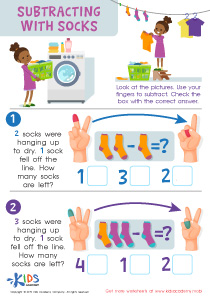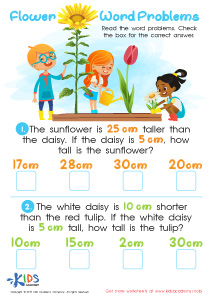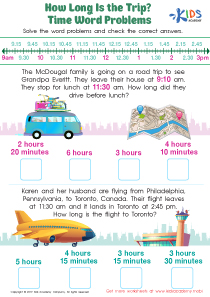Easy Graph Word Problems Worksheets for 7-Year-Olds
1 filtered results
-
From - To
Introduce your seven-year-old to the fascinating world of graphs with our Easy Graph Word Problems worksheets! Designed specifically for young learners, these sheets combine fun and education in a visually engaging format. Each worksheet is crafted to enhance comprehension and analytical skills through interactive learning experiences. These learning interactive worksheets focus on interpreting simple graphs and solving basic word problems, making them perfect for beginners. Watch your child's confidence grow as they tackle each problem with enthusiasm and curiosity. Ideal for home or classroom use, these worksheets are a brilliant resource for nurturing budding mathematical skills.


Coffeehouse Survey: Picture Graph Word Problems Worksheet
Why Easy Worksheets on Graph Word Problems Are Useful for Children Aged Seven
In the foundational years of education, the tools and methods we choose to impart learning play a crucial role in shaping a child’s academic growth and understanding of concepts. For seven-year-old children, grasping the basics of graphs through word problems can be made engaging and effective with the use of learning interactive printables, specifically designed as easy worksheets. These worksheets are not only educational but also fun, fostering an early love for mathematics and problem-solving.
Making Mathematics Engaging
Graph word problems can seem daunting at first glance to a young learner. However, when presented through easy worksheets that are colorful, interactive, and tailored to their level of understanding, these problems become less intimidating. Learning interactive printables are designed to capture the attention of children, using themes and characters they find relatable and enjoyable. This approach helps in transforming a potentially dry subject into something that a child looks forward to practicing.
Building Fundamental Skills
At seven years old, children are at a critical stage of their cognitive development, where they are beginning to understand more complex concepts and enhance their critical thinking skills. Easy worksheets on graph word problems introduce these young learners to the concept of representing data visually. This not only aids in improving their analytical skills but also enhances their ability to interpret information and draw conclusions—skills that are vital across all subjects.
Encouraging Independent Learning
Learning interactive printables are designed in such a way that they encourage children to work independently. These worksheets usually come with clear instructions and examples that guide the child through the process of solving graph word problems. This promotes self-reliance and confidence in their ability to tackle new challenges without immediate assistance, fostering a sense of achievement and independence in young learners.
Supporting Personalized Learning
Every child learns at their own pace, and easy worksheets can be adapted to meet individual learning needs. Whether a child grasps concepts quickly or needs a little extra time and practice, learning interactive printables can accommodate these differences. Educators and parents can choose worksheets with varying levels of difficulty and different types of graph problems, ensuring a tailored learning experience that matches the child’s personal learning journey.
Enhancing Problem-Solving Skills
Graph word problems require a child to not only understand the information presented in graphical form but also solve related questions using this data. This dual requirement ensures that children enhance their problem-solving skills. Easy worksheets provide a scaffolded learning experience, where children learn to approach a problem from multiple angles and use logic to find solutions. By engaging with these worksheets, children develop a structured approach to problem solving that goes beyond mathematics.
Interactive Learning Experience
What makes learning interactive printables particularly effective is their interactive nature. These worksheets often incorporate elements that require active engagement from the child, such as matching graphs to the correct interpretations, plotting points on a blank graph, or even creating their own simple graphs based on given data. This hands-on approach ensures that children are not passive recipients of information but active participants in their learning process.
Reinforcement of Learning
Consistent practice is key in mastering any new skill, and easy worksheets provide a perfect platform for this. With repetitive yet varied problems, children can practice the same concepts until they become second nature. This repetition helps in reinforcing what they have learned and aids in long-term retention of the skills.
Preparing for Future Academic Challenges
The skills learned from graph word problems are not limited to elementary mathematics. They form a foundational base for more advanced mathematical concepts and real-world applications that children will encounter as they advance in their education. Early exposure through engaging and comprehensible easy worksheets equips children with the confidence and skills needed to face more complex challenges in the future.
Conclusion
Easy worksheets on graph word problems, enhanced with learning interactive printables, offer a multitude of benefits for children aged seven. They make learning engaging, promote independence, cater to individual learning styles, improve problem-solving skills, and prepare children for future academic tasks. By integrating these educational tools into the learning process, parents and educators can provide a strong mathematical foundation that supports academic success across various subjects. In this way, these interactive printables are not just tools for learning but stepping stones towards comprehensive intellectual growth for young learners.

 Assign to the classroom
Assign to the classroom





